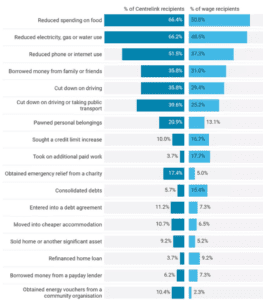An extraordinary number of Australians are feeling financially stressed and struggling under the weight of debt. This is difficult for the individuals involved, and should be seen as a warning bell for everyone, from lenders to business owners and property investors.
NAB and the Centre for Social Impact’s recent research, for example, has estimated that 2.1 million Australians are experiencing severe or high financial stress. Their survey found that one in five adults feels over-indebted and one in six is struggling to meet the basic costs of living.
But what does living under the weight of debt look like? How do people experiencing financial hardship cope? To find out, researchers from the University of Melbourne surveyed 1,101 Australian adults who had been unable to pay a debt within the past two years. Their findings show that financial hardship can deeply impact health, relationships and general wellbeing. Financial difficulty ranges from a temporary earnings shortfall to serious and ongoing deprivation.
According to the survey, more than a third (36%) of adults experienced mental health problems and more than a quarter (27.5%) suffered physical health problems after they started having debt issues. About a fifth (21.6%) had trouble maintaining their relationships with family and friends.
Figure 1: Aspects of life affected by Australian adults’ debt problems

While falling into arrears was stressful for respondents regardless of their income level, the study reveals that those who relied on Centrelink payments were more susceptible to financial hardship than those who depended on wages for income. Centrelink recipients included individuals who received unemployment, disability and Age Pension benefits.
The study also found that debt problems weren’t new for many of the respondents. More than a quarter (27.4%) started struggling to pay a debt more than five years ago. For about 22% of the respondents, difficulties began two to five years earlier.
Dealing with burden of debt
To cope with their financial hardship, respondents largely resorted to spending less. They mostly reduced their expenditures on food (57.8% of respondents), recreation (56.8%), utilities (55.5%), phone or internet use (43.7%), medical care (32.5%) or transport (32.3%). Others borrowed money from family or friends, reorganised their finances, consolidated debts, entered into a debt agreement, refinanced their home loan or pawned personal belongings.
Figure 2: Ways Australian adults are coping since their debt problems started

Not surprisingly, more Centrelink recipients than wage earners had to trim their expenses and seek help. For example, the proportion of Centrelink beneficiaries who received emergency relief from a charity group or energy vouchers from a community organisation was three times more than that of wage earners.
But do these coping strategies work? For less than half (42.6%) of respondents, their financial situation had improved since their debt trouble started. But for nearly 44% – more of them Centrelink beneficiaries than wage earners – it hadn’t really changed.
Many of the those who said their financial standing had not improved cited broader socio-economic issues, such as the rising cost of living, as reasons.
“Financial hardship can affect almost anyone,” said the researchers. “However, severe and ongoing debt problems are an inevitability for Australians whose incomes are simply too low to meet the cost of living.”




